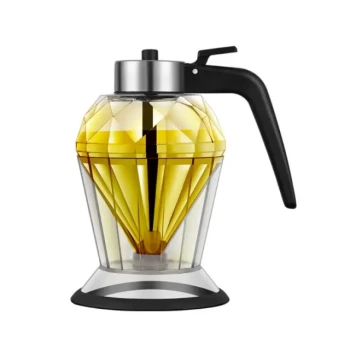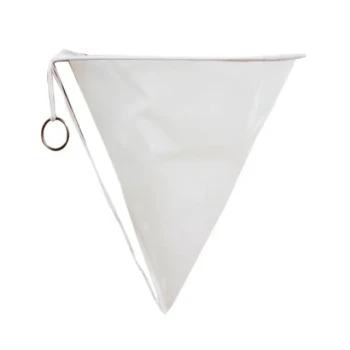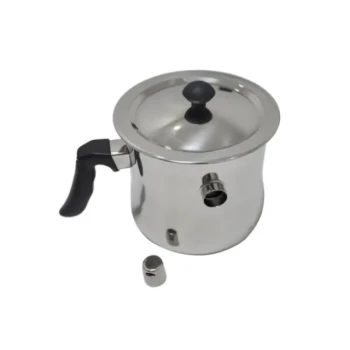The primary benefits of an electric honey warmer are rooted in precise temperature control. They are designed to gently heat honey, preventing crystallization and maintaining the perfect viscosity for bottling, which in turn saves money and eliminates product waste.
The core challenge in honey processing is managing its natural tendency to crystallize and thicken without damaging its delicate qualities. An electric honey warmer solves this by applying consistent, low-level heat, preserving the honey's integrity while making it vastly easier to handle and bottle.
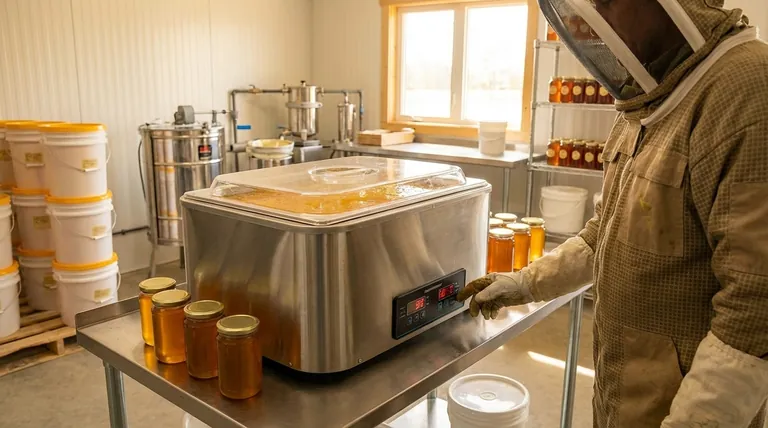
Why Precise Temperature Control is Critical
The quality and usability of honey are directly tied to its temperature. Uncontrolled heating or chilling can fundamentally alter the product you've worked hard to produce.
Preventing Crystallization
Crystallization is a natural process where glucose separates from water in the honey. While not a sign of spoilage, it makes honey difficult to manage and undesirable for many consumers.
A honey warmer applies gentle, consistent heat that dissolves existing crystals and prevents new ones from forming, keeping the honey perfectly clear and liquid.
Achieving Perfect Viscosity
Viscosity refers to the thickness of a liquid. Cold honey is extremely viscous and difficult to pour, filter, and bottle.
By maintaining an optimal temperature, a warmer makes the honey flow smoothly. This ensures a faster, cleaner, and more efficient bottling process.
Preserving Honey's Natural Qualities
Aggressive heating methods can be destructive. Overheating honey can destroy its beneficial enzymes, darken its color, and alter its delicate flavor profile.
Electric honey warmers are specifically engineered for low-and-slow heating, preserving the natural quality that makes your honey a premium product.
The Tangible Economic Advantages
Beyond maintaining quality, a honey warmer has a direct and positive impact on the financial viability of your operation.
Eliminating Product Waste
Thick, crystallized honey clings to the sides of buckets, tanks, and bottling equipment. This leftover product represents lost revenue.
Warming the honey ensures that every last drop flows freely, maximizing the amount of product you can actually sell.
Saving Time and Labor
Struggling to scoop, pour, and filter semi-solid honey is a time-consuming and physically demanding task.
A honey warmer streamlines the entire workflow. The time and effort saved can be redirected to other critical aspects of your business.
Unlocking Crystallized Stock
An electric warmer can reclaim honey that has already fully crystallized. This turns what was once unsellable stock back into a valuable, liquid asset.
Understanding the Trade-offs
While highly beneficial, it's important to approach this equipment with a complete understanding of its operational realities.
The Initial Investment
Specialized equipment like an electric honey warmer requires an upfront capital investment. For very small-scale hobbyists, this cost must be weighed against the volume of honey they process.
The Risk of Incorrect Use
While designed for safety, any heating element carries risks. Using a warmer improperly or attempting to rush the process by setting the temperature too high can still damage the honey, defeating its purpose.
Energy Consumption
As an electric appliance, a honey warmer will contribute to your energy costs. While typically efficient, this is an ongoing operational expense to consider.
Making the Right Choice for Your Goal
The decision to invest in an electric honey warmer should align with your specific operational priorities.
- If your primary focus is product quality and consistency: A warmer is essential for preventing crystallization and protecting the delicate enzymes and flavor of your honey.
- If your primary focus is maximizing profit and reducing waste: The ability to reclaim crystallized honey and completely empty containers makes a warmer a sound financial decision.
- If your primary focus is operational efficiency: A warmer will dramatically reduce the time and physical effort required to filter, process, and bottle your honey.
Ultimately, an electric honey warmer is a strategic tool for maintaining product integrity and improving your operational workflow.
Summary Table:
| Benefit | Key Impact |
|---|---|
| Precise Temperature Control | Prevents crystallization, preserves natural enzymes and flavor. |
| Perfect Viscosity | Enables smooth, efficient pouring, filtering, and bottling. |
| Eliminates Product Waste | Maximizes yield by ensuring honey flows freely from containers. |
| Saves Time & Labor | Streamlines workflow, reducing physical effort and processing time. |
| Reclaims Crystallized Stock | Turns unsellable, solidified honey back into a liquid asset. |
Ready to boost your honey processing efficiency and profitability?
As a leading wholesale supplier to commercial apiaries and beekeeping equipment distributors, HONESTBEE provides robust, reliable electric honey warmers designed for high-volume operations. Our equipment helps you protect your product quality, maximize yield, and streamline your workflow.
Contact our expert team today to discuss your specific needs and discover how our beekeeping supplies can enhance your operation's bottom line.
Visual Guide
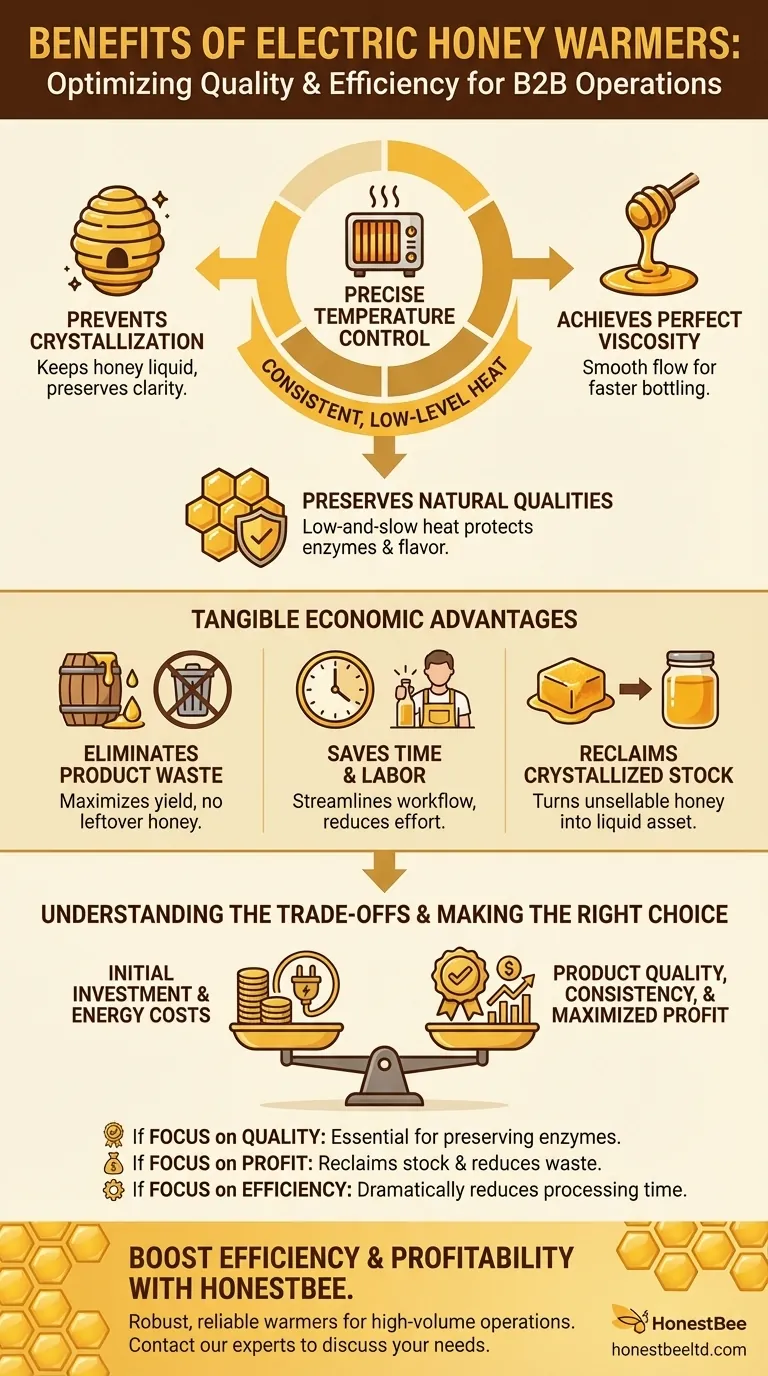
Related Products
- HONESTBEE 72 Frame Industrial Electric Honey Extractor for Beekeeping
- 8-Frame Electric Self-Reversing Honey Extractor Spinner for Commercial Honey Extraction Equipment
- HONESTBEE 8 Frame Electric and Manual Three Use Honey Extractor
- 10L Stainless Steel Electric Honey Press Machine
- Honey Tank Heater Drum Heating Blanket for Honey Barrel
People Also Ask
- What is the energy consumption like for automatic honey extractors? Maximize Your Harvest Efficiency
- What are the advantages of automated honey extractors in terms of time efficiency? Boost Your Harvest Speed
- Why is preserving honeycomb integrity important, and how do automated extractors help? Boost Hive Health & Honey Yields
- How do automatic honey extractors function? Achieve High-Efficiency Honey Harvesting
- How is honey harvested from Langstroth hives? A Guide to Efficient, Comb-Preserving Extraction









